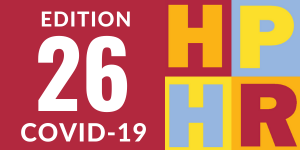
Irfan A, Sifat M, Brown Z. Misinformation, health equity, news media: application of critical race theory (CRT) to examine news media’s role in normalizing religious bigotry. Harvard Public Health Review. 2021; 26.
DOI:10.54111/0001/Z2
One of the unintended consequences of infodemics is the subtle misinformation, especially through nonverbalized images, which often goes unexamined. In an age of (mis)infodemics, the role of news media is critical in the spread or containment of misleading information ranging from public health to religious intolerance. News media wields the power to influence public opinions, attitudes, beliefs, and even determine public agenda. News media have a history of biased reporting and influencing public opinion. Much like propaganda, it upholds status-quo perceptions on issues such as race, police brutality, terrorism, and religious bigotry. During the current COVID-19 pandemic, news media have subtly spread misleading information through story image selection, which perpetuates and exacerbates Islamophobia. We document a pattern of misleading news story images and draw from interdisciplinary research to reflect on the public health and health equity implications of the spread of such misleading information on the Muslim community in the United States. News media’s role in a free society as a neutral, transparent entity is critical that provides objective information instead of misleading stories such as sensationalized clickbait. We must hold news media to a higher standard to achieve an open, fair, and free society. News media can ‘flatten the curve’ of religious bigotry, racial biases, and misinformation by adhering to a system of accountability.
News media is a strong force that has the power to inform public beliefs, views, and public policy agendas. It can also just as effectively be used to misinform. In an era of infodemics and misinfodemics, the news media plays an increasingly critical role (Happer & Philo, 2013) in informing the public about world events as well as educating them regarding subjects about which they lack knowledge. News media has the ability to not only inform the public, but to construct their social realities, beliefs, and attitudes. In other words, manufacturing consent (Herman & Chomsky, 2002). Evidence suggests that the news media has ‘subtle, persuasive, and pervasive’ effects on shifting the public’s beliefs through repetitive messaging (Eveland, 2012). These beliefs become opinions, behaviors, and public policies. In the eyes of the public, when the news media report misinformation, it is perceived as accurate information, which influences their opinions, beliefs, attitudes, and behaviors. This phenomenon is a serious cause for concern that should give us all pause.
With an increasingly polarized country and a history of misleading the public on historical international injustices leading to gross human rights abuses such as the Iraq War, the news media have seen increasing levels of distrust among the public. In the current pandemic, only 44% of adult Americans approve of media reporting (FAIR, 2007; Newport, 2020). Throughout the pandemic, the news media have taken a subtle approach of leading the charge of spreading misinformation. Specifically linking COVID-19 with Islam. Although not a thorough qualitative content analysis, we have crowdsourced and documented several news articles about COVID-19 that contain photos depicting artifacts associated with Islam and Muslims, even though such artifacts are entirely irrelevant to the stories they are accompanying (Figures 1-7).
This willful and dangerous vilification of religious minorities by portraying their religion as linked to death, animosity, and disease is not a nascent phenomenon. Islam and Muslims have specifically been covered negatively in the news media, exacerbating both Islamophobia and the health inequities across the Muslim population (Saeed, 2007). The Media Portrayals of Minorities Project at the Middlebury College reports that Muslims are by far the most negatively portrayed religious group in the U.S. (Iftikhar, 2019). When it comes to terrorist attacks, researchers found that “when the perpetrator is Muslim, you can expect that attack to receive about four and a half times more media coverage than if the perpetrator was not Muslim,” and “a perpetrator who is not Muslim would have to kill on average about seven more people to receive the same amount of coverage as a perpetrator who’s Muslim” (Kearns, Betus & Lemieux, 2018). Comparable studies in the United Kingdom have found similar results (Waterson, 2019).
Blatant hatred and dehumanization towards Muslims, across the political ideological spectrum, is normalized and tolerated without question, especially on cable news (Fisher, 2015). Journalists do not face any repercussions as they would for making similar statements about virtually any other group. Some examples from a VOX article include:
“The Muslim world is responsible for a really big part of religious extremism right now. And they are unusually violent.”
– Chris Cuomo, CNN Tweet
“You can’t solve it with a summit. You solve it with a bullet to the head. It’s the only thing these people understand.”
– Andrea Tantaros, Fox News Tweet
“Does Islam promote violence?”
– Don Lemon, CNN Tweet
These are intellectually lazy, pejorative Islamophobic tropes perpetuated by pseudo-intellectuals that start with low-quality journalism and lead to a “racialized state surveillance” of Muslims (Alimahomed-Wilson, 2019). Although the focus of this article is anti-Muslim bigotry, intolerance towards religious minorities is commonplace in the US. We must acknowledge that no conversation about religious bigotry in the US would be complete without acknowledging that the U.S. news media, perhaps not the “mainstream,” are rife with covert anti-Semitic bigotry.
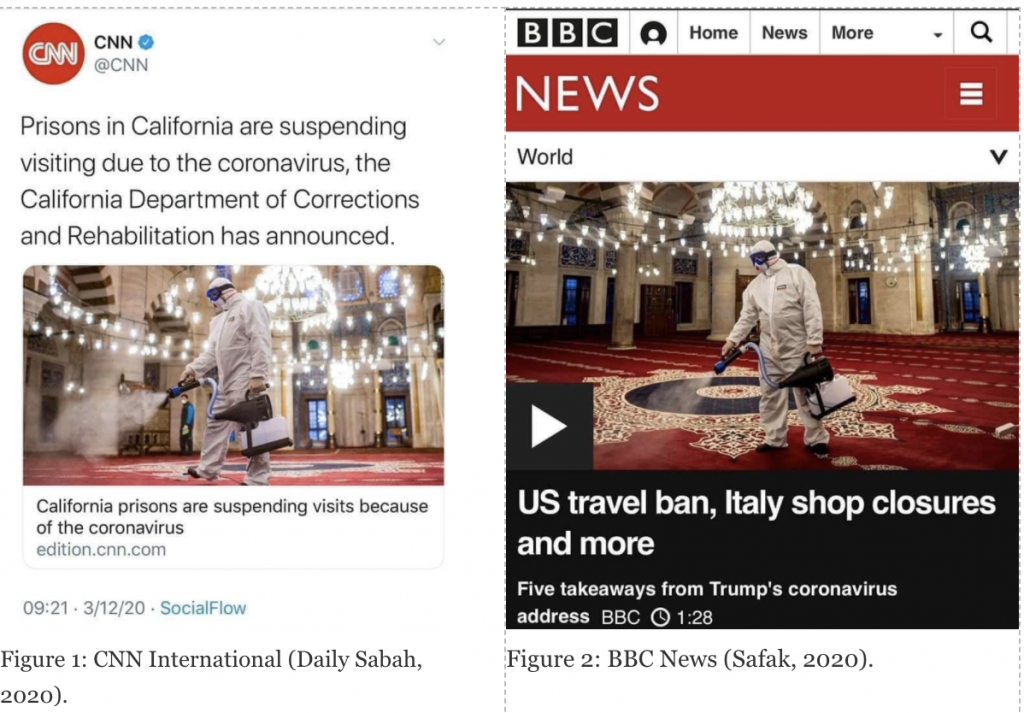
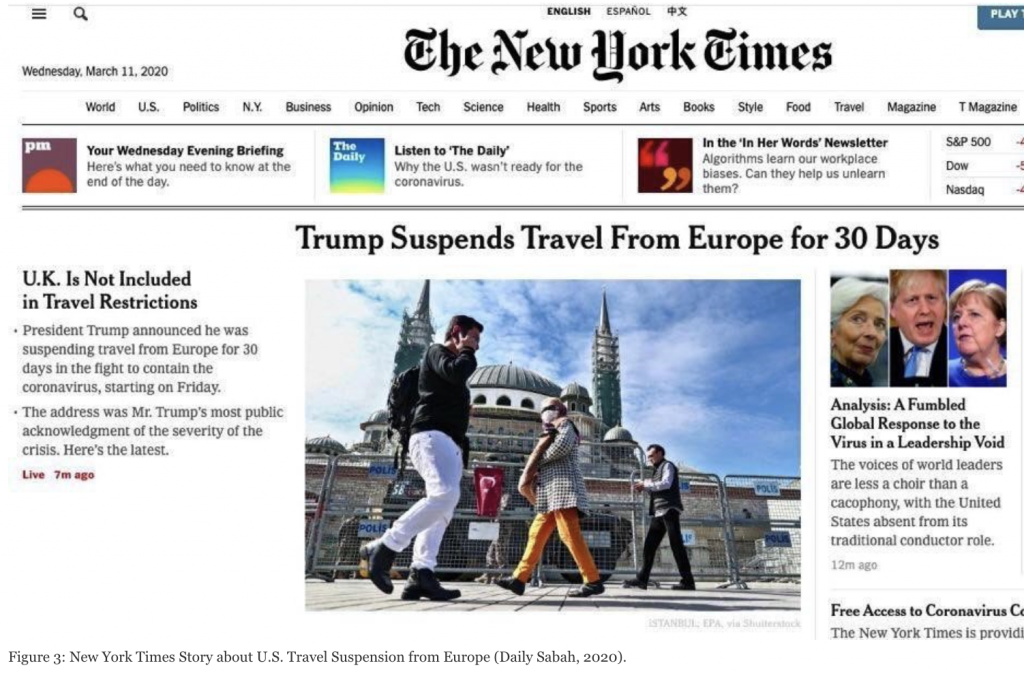
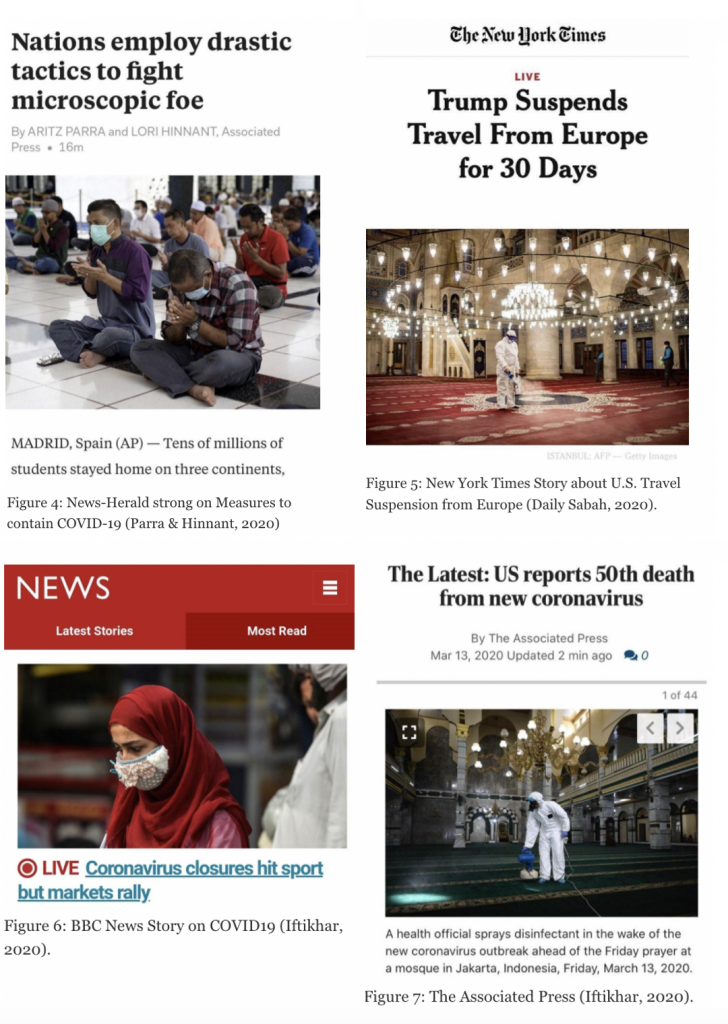
These are intellectually lazy, pejorative Islamophobic tropes perpetuated by pseudo-intellectuals that start with low-quality journalism and lead to a “racialized state surveillance” of Muslims (Alimahomed-Wilson, 2019). Although the focus of this article is anti-Muslim bigotry, intolerance towards religious minorities is commonplace in the US. We must acknowledge that no conversation about religious bigotry in the US would be complete without acknowledging that the U.S. news media, perhaps not the “mainstream,” are rife with covert anti-Semitic bigotry.
Although this discussion presents the news media’s role in maintaining Islamophobia, religious bigotry conveyed in the news is not a new phenomenon. Judaism (Figure 8) and Catholicism (Figure 9), among other faiths, have often been manipulated and repositioned under a hateful framework. These media portrayals continue to ignite the American public’s fears. More recently, the abhorrent news of a man waving a swastika flag at Senator Bernie Sanders, the only Jewish person who came close to the U.S. presidency, a milestone in itself – and hopefully not the last -, was ignored by tv news media (Sibai, 2020). The print news media covering the story trivialized the urgency of highlighting such a hateful event, despite an increasing number of anti-Semitic attacks in the U.S. (ADL, 2020). The news media coverage of the event was unreliable (Macleod, 2020). As presented by the Fair and Accuracy Reporting (FAIR) report, the coverage of this campaign has been imbued with anti-Semitic tropes and images, ranging from questionable to outright offensive portrayals (Figure 10, 11).
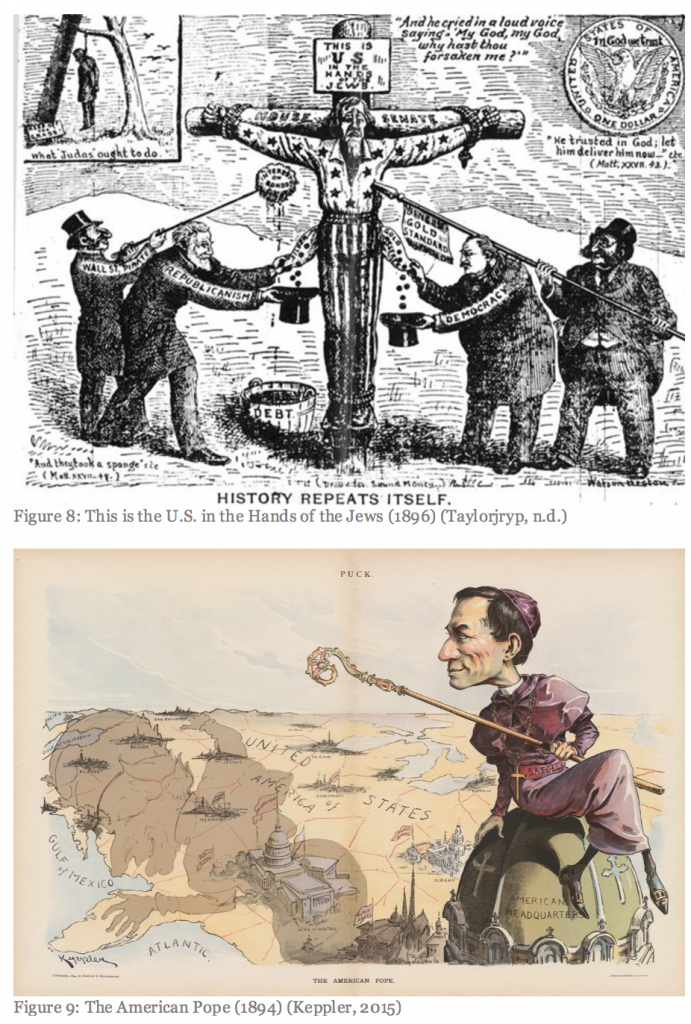
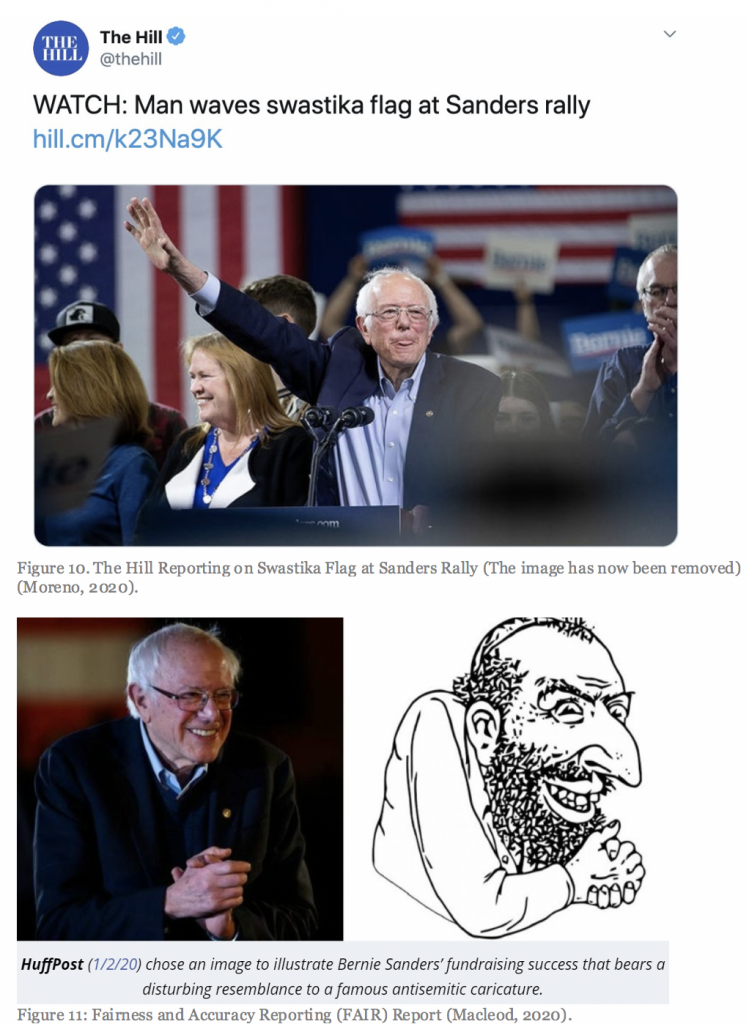
From Walter Lippman’s Public Opinion, assessing the media’s capacity to construct social realities, onwards, we know news media wields agenda-setting power (Brosius & Weimann, 1996; Luo et al., 2019). Visual images, specifically, have the ability to frame a subtle narrative while explicitly stereotyping a particular group, regardless of the intention (Reese et al., 2001). Visual images reinforce stereotypes and further pathologize existing negative views and prejudices. Without verbalizing, images in news stories convey dangerous messages with impunity, evoking subtle stereotypes, and creating hateful subtexts for discrimination. The U.S. media is notorious for “ambivalent racism” towards Muslims, portraying this group as a national security risk, perpetuating stereotypes, and the fiction of a post-racial society. As Evelyn Alsultany (2012) covers in Arabs and Muslims in the Media: Race and Representation After 9/11, the U.S. media’s portrayal of Muslims as a national security risk is in fact “ambivalent racism.” Even the American mass media portrayal of terrorists almost always depicts Muslims. This phenomenon is an extension of contemporary “Orientalism” and postcolonial scholarship (Said, 1979). A recent study presented to participants a series of news clips about Muslims, portrayed positively, negatively, and neutrally. They discovered that after participants watched the negative news clips regarding Muslims, they supported several unconstitutional policies targeting Muslim Americans (Saleem et al., 2017).
Critical Race Theory (CRT), with its origins in law, is a framework that enables the understanding of power dynamics; as these are informed by collective U.S. culture, values, and institutions, such as the news media (Delgado & Stefancic, 2017). It also promotes the importance of examining and understanding the experiences of minorities. CRT allows us to examine sociocultural forces that sustain persistent, systematic racism and decipher structural racism as it pertains to minority groups. This framework can also be used to understand how Islamophobia is perpetuated by subtle image selection in news media stories about Coronavirus. These news stories with curiously curated images, even without an in-depth, qualitative content analysis, tell a tale of power and privilege. Foundational to the interplay of power and privilege, these stories operate to dehumanize using Islamophobic narratives.
News media wields power to inform our world view (McCombs & Reynolds, 2002). Contemporarily, it is subtly framing the public narrative to inform unconscious cognitive biases among viewers. Despite having no association with Islam, artifacts of Muslim faith such as mosques, prayers, and hijabs are equated with words carrying negative, undesirable connotations. Some of the words picked from just the titles of these news stories with misleading images include: “foe,” “prisons,” “ban,” “closure,” “visit suspension,” “drastic tactics,” “travel suspension,” and “death.” By connecting the Muslim faith with such negative concepts and social ills, the news media is negatively defining perceptions of the social reality regarding Muslims. These images provoke Islamophobia and broaden the pretext for dehumanizing Muslims in the public psyche. The implications of these images further condone the “Fear of Muslims is RATIONAL: please forward this to others: the truth fears no questions…” narrative as captured in a Tweet by former National Security Advisor, Michael Flynn (Payton, 2016).
This uncritical, disappointingly intentional conduct has serious consequences, not limited to hate crimes and violence (USA, 2018). These bigoted views misinform the public, generating political will and embodiment of radical, Islamophobic, anti-American policy ideas. The public policy level translation of these ill-informed opinions is personified in public tolerance for policies such as mass surveillance, Muslim bans, and proposals of shutting down mosques and Muslim registries, the closing of Muslim owned businesses, and ‘patrol and secure’ Muslim neighborhoods (ACLU, 2020; ACLU – Muslim Ban, 2020; Krieg, 2015; Munzenrieder, 2015; Zezima & Adam, 2016). Some of these policies have been implemented, and the rest are not ‘fringe’ discussions, rather open public debates by national political figures during and since the 2016 Presidential Election.
Applying the CRT framework to analyze the differentials in the news media coverage shatters the notion of objectivity that should be the hallmark of news media and reporting. It also reveals a pattern of the news media’s role in upholding the status quo, power, and privilege for the few, and further exacerbating racism, health, and other inequities. There are many examples of media’s misleading portrayal of minority groups and erasure of culpability for others ranging from domestic homicides to international war crimes such as the utility of nuclear weapons. of Other than subtle Islamophobia, we share a select few examples of glaring discrepancies and biases in news media coverage, including the killing of unarmed Black Americans, homicide, sexual assault, and domestic terrorism.
News media coverage overwhelmingly associates criminality with Black people, particularly Black men (Oliver, 2003). Unarmed Black men are more likely to be shot and killed by police compared with their White counterparts (Edwards, Lee & Esposito, 2019). Research suggests that the negative portrayal of Black men in news media, including associating them with criminality, plays a critical role in informing police behavior and aggression towards Black men, as well as the public’s readiness to acquit police officers involved in such shootings (Cunnigen & Bruce, n.d; Smiley & Fakunle, 2016). This news media coverage discrepancy extends to non-law enforcement killing of Black men as well. For instance, Figure 12 shows a news story about Trayvon Martin, a 17-year-old Black high school student who was killed near his home, noting his school suspension record, which bears no relevance to his murder.
The scourge of terrorism, domestic or otherwise, is another case where one can observe clear bias in news media reporting. Robust research indicates that the terrorist attacks where the perpetrator was of Muslim faith received a 357% increase in news media coverage, misaligning reality with perception of Muslims as terrorists (Kearns, Betus & Lemieux, 2018). News media continues to push the ‘all terrorists are Muslims’ narrative. For many, this makes it easier to conclude all Muslims are terrorists when in fact, most terrorism victims in the world are Muslims (Kunst et al., 2012; Herrera, 2019). In cases of White culprits, news media and law enforcement treat the suspects with the “lone wolf” narrative that maintains the ‘only Muslims are terrorists’ stigma in the public’s minds (Beydoun, 2018). As Roy aptly puts, “we’re facing not a radicalization of Islam, but the Islamization of radicalism” (Roy, 2017). News media should play a neutral role, educating the public about Islam, a religion that has been a part of the US since its founding upon colonization, instead of being a propaganda machine perpetuating falsehood.
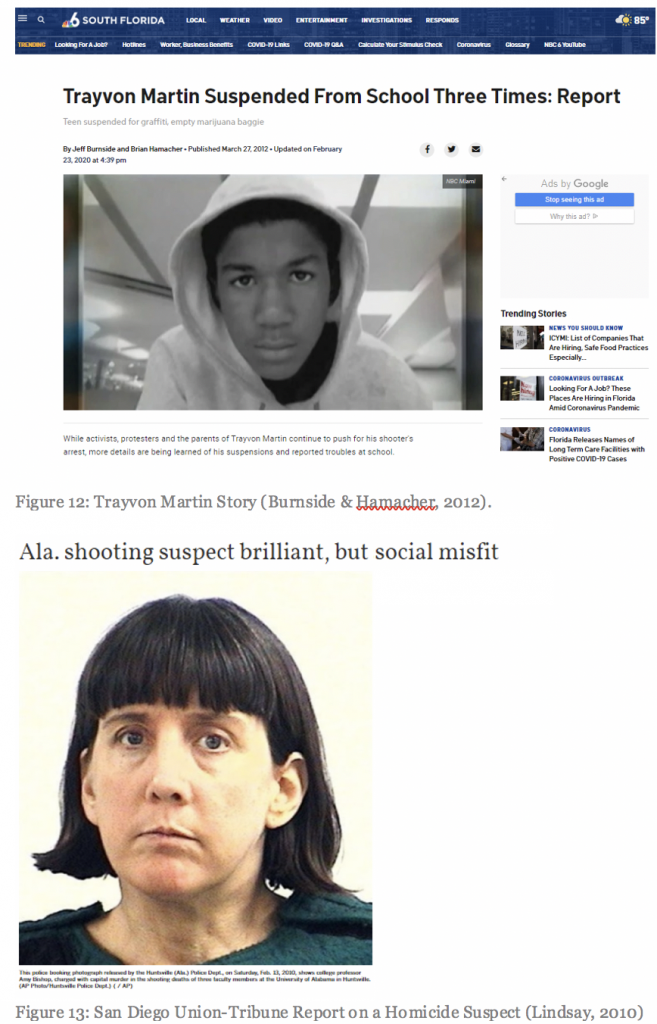
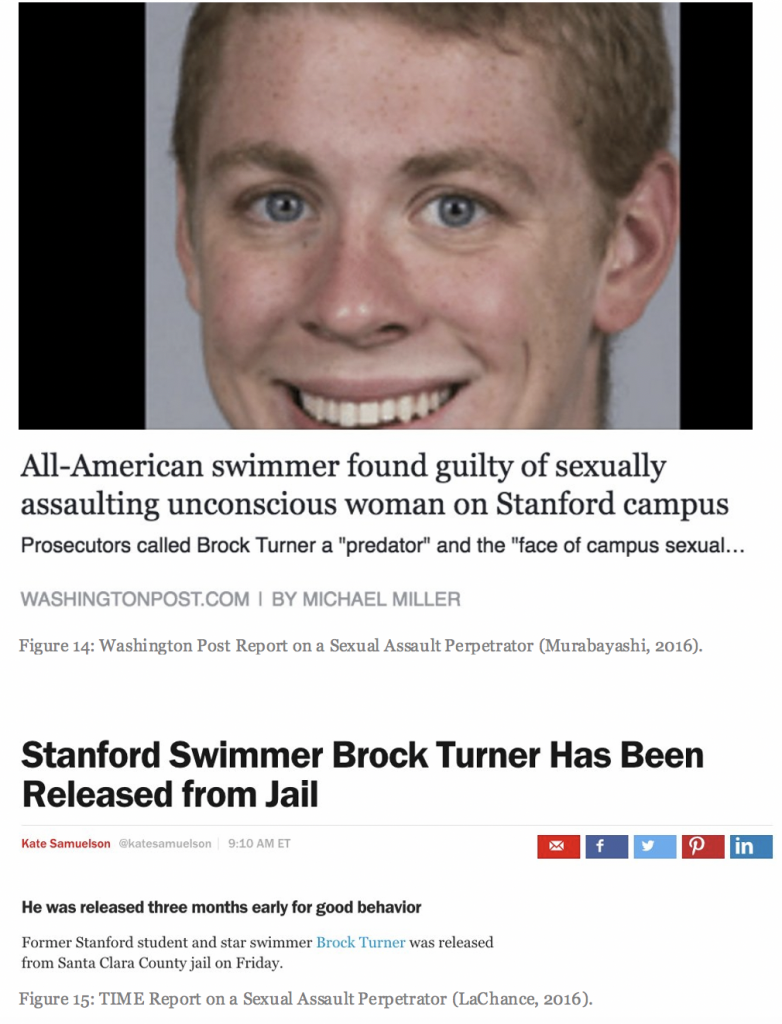
Rabid dogs, terrorists, complicit, and so on. Those are some of the words that have been used in the U.S. by major national political leaders to describe Muslims. Islamophobia has been increasing globally in the past years, the first rise being seen after 9/11, and another recent incline in 2015 amidst the last presidential election. Islamophobia has been normalized through news media, policies, and political misinformation. Globally, several western countries have banned clothing articles specific to Muslim women. These policies have led to discrimination, targeting, and criminalization of women in these countries. Ironically, and tragically given the pandemic, many countries are now requiring face masks as a public health prevention measure (Hasan, 2020). News media, along with the fashion industry (Figure 16), is now glamorizing face covers without an acknowledgment of the punitive regime that was imposed on women for doing the same thing for religious purposes. This display, which glorifies fashion forwardness over public health concern, is an exact demonstration of privilege and cultural appropriation.
Research indicates Muslim women wear a veil for many different reasons; religion, cultural identity, and so on (Wagner et al., 2012). Yet, the veil remains a symbol of “religious fundamentalism and patriarchal oppression.” It is crucial to acknowledge the oppressive, abusive role veils play in certain societies that sanction it through legislation or patriarchal social pressure. However, in an age of Ilhan Omar and Ibtihaj Muhammad, the “static colonial image of the oppressed veiled Muslim woman” in Western societies not only does not speak to their lived experiences, but also serves merely as chauvinistic, intellectually stagnant Islamophobic propaganda (Hoodfar, 1992; Wagner et al., 2012). If we are concerned with gender equality, we should focus our energies on strengthening domestic abuse laws, achieving reproductive justice, equal pay, and other public policies geared towards creating an equitable society for all women. Moreover, this is not a defense of the veil rather women’s right to choose as they please.
Countries like France and the United Kingdom have exacerbated Islamophobia in the name of the war on extremism (Beydoun, 2016; Allen et al., 2007). In the U.S., Muslims endure five times the amount of hate crimes now than they did before 9/11, and these crimes continue to increase (Muslim Advocates, 2020; Samari, Alcalá & Sharif, 2018). The Department of Homeland Security in partnership with local police departments has an anti-violent ideologies program called Countering Violent Extremism (CVE) for people “prone to radicalization” (DHS, 2020). However, the implementation of CVE has been discriminatory as it primarily targets poor, working-class and young, westernized Muslim men (Beydoun, 2016; Akbar, 2017). CVE targeting has been implemented in several U.S. cities, along with “Stop and Frisk” and “Knock and Talk” programs that have targeted Muslims along with other ethnic and racial minorities (Beydoun, 2016; Palatnik, 2012; Beydoun, 2016).
These policies do not come into existence in a vacuum. These are a product of a pervasive animosity towards Islam. “I think Islam hates us,” said the would-be U.S. President on the campaign trail, which was merely a verbalizing of religious bigotry furthered by news media’s uncritical reporting (Del Real, 2016). Soon after his election, the President called for a “total and complete shutdown of Muslims entering the United States,” a version of which was implemented in 2018 (ACLU, 2020; Harris, Shear & Nixon, 2017; Johnson & Weigel, 2015) . This travel ban had serious consequences, including over surveillance, fear and panic, and exacerbation of economic inequities in Muslim communities (Panduranga, Patel & Price, 2017; Beydoun, 2016; Beydoun, 2019).
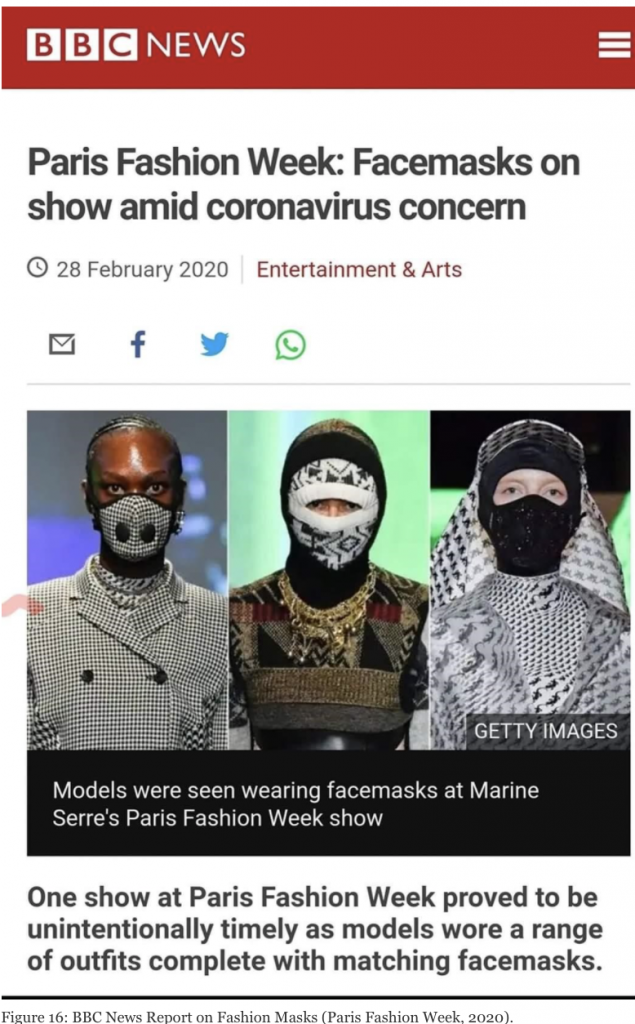
From a public health perspective, Islamophobia cannot be discussed without examining the intersectionality of poverty and race in the U.S. Roughly a fifth of American Muslims are Black (Mohamed & Diamant, 2019). Despite having similar levels of education as the general U.S. population, Muslims earn less, have lower homeownership, and are more likely to be under- and unemployed (Pew, 2017). To talk about Muslim Americans in broad brushstrokes will do no justice as the population varies among race, ethnicity, and socioeconomic class (Hammer, 2013). It is critical to highlight these disparities since the working-class Black Muslims bear the brunt of most of the interlocking systems of oppression such as the current policing structure (Beydoun, 2016). Black Muslims are often missing from the narratives about Islam, and U.S. Islam is considered a recent development. Islam came to American shores with enslaved people, 15-20% of enslaved persons in the U.S. were Muslim, and many were forced to convert to Christianity (PBS, n.d.). These cumulative, intersecting identities and social inequities baked in the systems make Muslims an even more vulnerable group.
Islamophobia and health inequities are tied together. Muslim communities face a disproportionate amount of stigma, and stigma is a fundamental cause of many health inequities (Hatzenbuehler, Phelan, Link, 2013). Operating at multiple levels – individual, interpersonal, systems – stigma can lead to cardiovascular diseases, violence, homicide, and suicide (New America, n.d.). Evidence suggests that discrimination is also associated with coronary artery calcification, high levels of C-reactive protein, high blood pressure, giving birth to low-birth-weight infants, cognitive impairment, poor sleep, visceral fat, depression, psychological distress, anxiety, and mortality, as well as risk factors contributing to substance abuse (Paradies et al., 2015; Samari, 2016). Stress and identity concealment effect on an individual level, social relationships, and socialization are impacted at the interpersonal level, and institutional policies and media coverage are found to impact well-being the macro-level (Samari, 2016). The implications of Islamophobia on mental health are also well-documented. For example, in New York City, after 9/11, Muslims reported fear of hate crimes and anxiety related to their safety, loss of community, isolation, and stigmatization (Abu-Ras & Abu-Bader, 2008). Being discriminated against at a structural level, through policy and media perpetration, heightens the risk of stigmatized identity (Pandela & Curlin, 2013). These inequities are further exacerbated by anti-Muslim policies in the U.S., which increase after a terrorist attack anywhere in the world (Figure 17).

The COVID-19 pandemic has provided us with an opportunity to reflect on almost all aspects of our society. It is a time for us to be self-reflective and move forward in a more transparent, inclusive manner. News media’s biased coverage that contributes to misinformation and baseless, propagandist rhetoric has serious public health consequences. In fact, it is a matter of life and death for many populations who experience vulnerabilities. Such behavior leads to intolerance, which further polarizes our country. It erodes the public’s trust in the news media as the ‘fourth branch of the government,’ and independent, unbiased sources of information (Braeman, 1985).
News media and the broader American society must address its persistent discrimination, overt hatred, and endearing bigotry towards Muslim Americans. For instance, the otherization benevolently expressed, albeit inadvertently, by former President Bill Clinton during the 2016 Democratic National Convention;
“If you’re a Muslim and you love America and freedom and you hate terror, stay here and help us win and make a future together. We want you”
(Drabold, 2016) Tweet
We must transcend implicit bias towards Muslim Americans. Muslim Americans are an integral part of American society; cooks, physicians, businesspersons, professors, neighbors, friends, family, and so on. Consider taking a moment of pause before demanding loyalties, pledges of patriotism, and apologies to reflect on the ridiculousness of such an assertion and whether we would ask the same of any other religious or ethnic group. We understand it is an era of clickbait journalism, sensationalized headlines, and the go-to boogeymen is suitable for the news media business. Hence, portraying Muslims as a monolithic entity through a prism of religious extremism is tempting as a business strategy. However, then, it is just that, a business strategy and propaganda rooted in misinformation – not journalism. News media and journalists should be conscious of the powerful, complex, and critical role news media plays in our democracy and for public health. This would entail self-reflection on behalf of the journalists and media entities that would require them to transcend the profit-oriented approach and hold themselves to higher standards. It is crucial to hold the news media accountable while upholding the independence of the press. We should promote media literacy among the U.S. public to help recognize that misinfodemics and pervasive clickbait journalism has far-reaching implications such as hatred, violence, and health inequities.
We briefly discuss privilege. White privilege, to be exact. We will not tiptoe around the issue that it may have made some of the readers uncomfortable. That may just be true for ‘intersectionality’ as well. These frameworks are not products of political correctness. Rather, a way of analyzing our positionality in a society. Most of us enjoy privileges in some shape or form; education, race, gender, sex, migration status, religion, and so on. Privilege is not peccant. It is merely acknowledging the advantages one might enjoy in a society, informing our world view, learning humility, and listening to those who lack such advantages. Ideally, using these advantages to promote equitable public policies and transformative social change. We also caution against the utility of this article as a blanket indictment of all news and mass media. Transparent, objective, and neutral news media is a critical part of a healthy, functioning democracy, a platform to contest ideas and public health efforts. However, like any other institution, it must be held accountable so we can move towards a more independent, literate, and transparent society.
“Nothing in all the world is more dangerous than sincere ignorance and conscientious stupidity.”
– Strength to Love – Martin Luther King Jr. (Ratcliffe, 2015) Tweet
Lorem ipsum dolor sit amet, consectetur adipiscing elit. Ut elit tellus, luctus nec ullamcorper mattis, pulvinar dapibus leo.
Abu-Ras, W., & Abu-Bader, S. H. (2008). The impact of the september 11, 2001, attacks on the well-being of Arab Americans in New York City. Journal of Muslim Mental Health, 3(2), 217–239. https://doi.org/10.1080/15564900802487634
Akbar, A. (2017). Policing “Radicalization.” http://www.fbi.gov/stats-services/publications/terrorism-2002-2005/terror02
Allen, C., Amiraux, V., Choudhury, T., Godard, B., Karich, I., Rigoni, I., Roy, O., & Silvestri, S. (2007). European Islam Challenges For Public Policy and Society.
Alimahomed-Wilson, S. (2019). When the FBI Knocks: Racialized State Surveillance of Muslims. Critical Sociology, 45(6), 871–887. https://doi.org/10.1177/0896920517750742
Alsultany, E. (2012). Arabs and Muslims in the Media: Race and Representations after 9/11. NYU Press. https://nyupress.org/9780814707326/arabs-and-muslims-in-the-media/
New America. Anti-Muslim Activities in the United States. (n.d.). New America. Retrieved April 19, 2020, from https://www.newamerica.org/in-depth/anti-muslim-activity/
ADL. Anti-Semitism in the US. (n.d.). Anti-Defamation League. Retrieved April 19, 2020, from https://www.adl.org/what-we-do/anti-semitism/anti-semitism-in-the-us
Al-Sibai, N. (2020). TV news ignores Nazi flag flown at Bernie Sanders rally | Media Matters for America. Media Matters. https://www.mediamatters.org/bernie-sanders/tv-news-ignores-nazi-flag-flown-bernie-sanders-rally
Beydoun, K. A. (2019). The Ban and the Borderlands Within: The Travel Ban as a Domestic War on Terror Tool. Stanford Law Review. https://www.stanfordlawreview.org/online/the-ban-and-the-borderlands-within-the-travel-ban-as-a-domestic-war-on-terror-tool/
Beydoun, K. A. (2018). Lone wolf terrorism: Types, stripes, and double standards. Northwestern University Law Review, 112(5), 1213–1244. https://papers.ssrn.com/abstract=3145300
Beydoun, K. A. (2016). America, Islam, and Constitutionalism: Muslim American Poverty and the Mounting Police State. Journal of Law and Religion, 31(3), 279–292. https://doi.org/10.1017/jlr.2016.33
Beydoun, K. A. (2016). Islamophobia: Toward a Legal Definition and Framework. https://papers.ssrn.com/abstract=2933156
Braeman, J. (1985). The Media in Politics: “The Fourth Branch of Government”? Canadian Review of American Studies, 16(3), 353–372. https://doi.org/10.3138/cras-016-03-10
Brosius, H.-B., & Weimann, G. (1996). Who Sets the Agenda. Communication Research, 23(5), 561–580. https://doi.org/10.1177/009365096023005002
Burnside, J., & Hamacher, B. (2012). Trayvon Martin Suspended From School Three Times: Report – NBC 6 South Florida. NBC Miami. https://www.nbcmiami.com/news/local/trayvon-martin-suspended-from-school-three-times-report/1919381/
Cunnigen, D., & Bruce, M. (n.d.). Research in Race and Ethnic Relations. Emerald Publishing. Retrieved April 19, 2020, from https://www.emeraldgrouppublishing.com/archived/products/books/series.htm%3Fid=0195-7449
Daily Sabah, A. (2020). BBC insists on using misleading Turkey photos for coronavirus news. Daily Sabah. https://www.dailysabah.com/politics/diplomacy/western-medias-use-of-misleading-turkey-photos-in-coronavirus-news-draws-criticism
Daily Sabah. (2020). Western media misled public using photos from Turkey to report on Europe flight ban. Daily Sabah. http://www.sanalbasin.com/us-travel-ban-to-europe-nyt-bbc-mislead-public-with-photos-from-turkey-35038823
Delgado, R., & Stefancic, J. (2017). Critical Race Theory (Third Edition). NYU Press. https://nyupress.org/9781479802760/critical-race-theory-third-edition/
Del Real, J. A. (2016). Trump: ‘I think Islam hates us.’ – The Washington Post. The Washington Post. https://www.washingtonpost.com/news/post-politics/wp/2016/03/09/trump-i-think-islam-hates-us/
Pew. Demographic portrait of Muslim Americans. (2017). Pew Research Center. https://www.pewforum.org/2017/07/26/demographic-portrait-of-muslim-americans/
DHS Countering Violent Extremism Grants. (2020). Department of Homeland Security. https://www.dhs.gov/cvegrants
Drabold, Wi. (2016). DNC: Read Bill Clinton’s Speech Transcript. Time. https://time.com/4425599/dnc-bill-clinton-speech-transcript-video/
Duxbury, S. W., Frizzell, L. C., & Lindsay, S. L. (2018). Mental Illness, the Media, and the Moral Politics of Mass Violence. Journal of Research in Crime and Delinquency, 55(6), 766–797. https://doi.org/10.1177/0022427818787225
Edwards, F., Lee, H., & Esposito, M. (2019). Risk of being killed by police use of force in the United States by age, race–ethnicity, and sex. Proceedings of the National Academy of Sciences of the United States of America, 116(34), 16793–16798. https://doi.org/10.1073/pnas.1821204116
Eveland, W. P. (2012). The Impact of News and Entertainment Media on Perceptions of Social Reality. In The Persuasion Handbook: Developments in Theory and Practice (pp. 691–728). SAGE Publications, Inc. https://doi.org/10.4135/9781412976046.n31
FAIR. (2007). Iraq and the Media: A Critical Timeline — FAIR. https://fair.org/take-action/media-advisories/iraq-and-the-media/
ACLU. Factsheet: The NYPD Muslim Surveillance Program. (2020). ACLU. Retrieved April 19, 2020, from https://www.aclu.org/other/factsheet-nypd-muslim-surveillance-program
Fisher, M. (2015). It’s not just Fox News: Islamophobia on cable news is out of control – Vox. Vox. https://www.vox.com/2014/10/8/6918485/the-overt-islamophobia-on-american-tv-news-is-out-of-control
Hammer, J. (2013). The Cambridge Companion to American Islam. Cambridge University Press. https://www.amazon.com/Cambridge-Companion-American-Companions-Religion/dp/0521175526
Happer, C., & Philo, G. (2013). The role of the media in the construction of public belief and social change. Journal of Social and Political Psychology, 1(1), 321–336. https://doi.org/10.5964/jspp.v1i1.96
Harris, G., Shear, M. D., & Nixon, R. (2017). Administration Moves to Carry Out Partial Travel Ban. The New York Times. https://www.nytimes.com/2017/06/29/us/politics/travel-ban-trump-muslims.html
Hasan, M. (2020). The Coronavirus Exposes the Idiocy of Islamophobia. The Intercept. https://theintercept.com/2020/04/14/coronavirus-muslims-islamophobia/
Muslim Advocates. Hate Crimes. (2020). Retrieved April 19, 2020, from https://muslimadvocates.org/issue/hate-crimes/
Hatzenbuehler, M. L., Phelan, J. C., & Link, B. G. (2013). Stigma as a fundamental cause of population health inequalities. American Journal of Public Health, 103(5), 813–821. https://doi.org/10.2105/AJPH.2012.301069
Herman, E., & Chomsky, N. (2002). Manufacturing Consent: The Political Economy of the Mass Media by Edward S. Herman. Pantheon. https://www.goodreads.com/book/show/12617.Manufacturing_Consent
Herrera, J. (2019). Most Terrorism Victims Are Muslim. Pacific Standard. https://psmag.com/news/most-terrorist-victims-are-muslim
Hoodfar, H. (1992). The Veil in Their Minds and on Our Heads: The Persistence of Colonial Images of Muslim Women. Resources for Feminist Research.
Iftikhar, A. (2020). Arsalan Iftikhar on Twitter: “Dear Global Media, Please stop promoting #Islamophobia with disproportionate numbers of #Muslim stock photos for your #Coronavirus stories… Thanks, 1.7 Billion Muslims https://t.co/NPklJfWHFT” / Twitter. Twitter. https://twitter.com/TheMuslimGuy/status/1238855208798760960?s=20
Iftikhar, A. (2019). Report: Muslims Most Negatively Portrayed Minority in US Media – Bridge Initiative. Bridge, Georgetown. https://bridge.georgetown.edu/research/report-muslims-most-negatively-portrayed-minority-in-us-media/
PBS. Islam In America. (n.d.). PBS. Retrieved April 19, 2020, from https://www.pbs.org/opb/historydetectives/feature/islam-in-america/
Johnson, J., & Weigel, D. (2015). Donald Trump calls for ‘total’ ban on Muslims entering United States – The Washington Post. The Washington Post. https://www.washingtonpost.com/politics/2015/12/07/e56266f6-9d2b-11e5-8728-1af6af208198_story.html
Kearns, E., Betus, A., & Lemieux, A. (2018). Why Do Some Terrorist Attacks Receive More Media Attention Than Others? SSRN Electronic Journal. https://doi.org/10.2139/ssrn.2928138
Keppler, U. J. (2015). The American Pope – Cornell University Library Digital Collections: Persuasive Maps: PJ Mode Collection. Keppler & Schwartzman, Publishers. https://digital.library.cornell.edu/catalog/ss:3293832
Krieg, G. (2015). Donald Trump: “Strongly consider” shutting mosques. CNN Politics. https://www.cnn.com/2015/11/16/politics/donald-trump-paris-attacks-close-mosques/index.html
Kunst, J. R., Tajamal, H., Sam, D. L., & Ulleberg, P. (2012). Coping with Islamophobia: The effects of religious stigma on Muslim minorities’ identity formation. International Journal of Intercultural Relations, 36(4), 518–532. https://doi.org/10.1016/j.ijintrel.2011.12.014
LaChance, N. (2016). Media Continues to Refer to Brock Turner as a “Stanford Swimmer” Rather Than a Rapist. The Intercept. https://theintercept.com/2016/09/02/media-continues-to-refer-to-brock-turner-as-a-stanford-swimmer-rather-than-a-rapist/
Lindsay, J. (2010). Ala. shooting suspect brilliant, but social misfit. The San Diego Union – Tribune. https://www.sandiegouniontribune.com/sdut-ala-shooting-suspect-brilliant-but-social-misfit-2010feb20-story.html
Luo, Y., Burley, H., Moe, A., & Sui, M. (2019). A Meta-Analysis of News Media’s Public Agenda-Setting Effects, 1972-2015. Journalism & Mass Communication Quarterly, 96(1), 150–172. https://doi.org/10.1177/1077699018804500
Macleod, A. (2020). It’s Media—Not Bernie Sanders—That Have an Antisemitism Problem — FAIR. FAIR. https://fair.org/home/its-media-not-bernie-sanders-that-have-an-antisemitism-problem/
McCombs, M., & Reynolds, A. (2002). News influence on our pictures of the world. Lawrence Eribaum Associates Publishers. https://psycnet.apa.org/record/2002-00742-001
Mohamed, B., & Diamant, J. (2019). Black Muslims account for a fifth of all U.S. Muslims. Pew Research Center. https://www.pewresearch.org/fact-tank/2019/01/17/black-muslims-account-for-a-fifth-of-all-u-s-muslims-and-about-half-are-converts-to-islam/
Moreno, J. E. (2020). Man removed from Sanders rally after waving swastika flag. The Hill. https://thehill.com/homenews/campaign/486285-man-removed-from-sanders-rally-after-waving-swastika-flag
Munzenrieder, K. (2015). Marco Rubio Wants To Shut Down Muslim Cafés and Diners, Maybe Some Mosques Too. Miami News Times. https://www.miaminewtimes.com/news/marco-rubio-wants-to-shut-down-muslim-caf-s-and-diners-maybe-some-mosques-too-8064185
Murabayashi, A. (2016). A Convicted Felon and His Portrayal in the Media. PhotoShelter Blog. https://blog.photoshelter.com/2016/06/a-convicted-felon-and-his-portrayal-in-the-media/
Newport, F. (2020). Six Emerging Conclusions: Public Opinion and COVID-19. Gallup. https://news.gallup.com/opinion/polling-matters/304646/five-emerging-conclusions-public-opinion-covid.aspx
Oliver, M. B. (2003). African American Men as “Criminal and Dangerous”: Implications of Media Portrayals of Crime on the “Criminalization” of African American Men. In Journal of African American Studies (Vol. 7, pp. 3–18). Springer. https://doi.org/10.2307/41819017
Padela, A. I., & Curlin, F. A. (2013). Religion and Disparities: Considering the Influences of Islam on the Health of American Muslims. Journal of Religion and Health, 52(4), 1333–1345. https://doi.org/10.1007/s10943-012-9620-y
Paris Fashion Week: Facemasks on show amid coronavirus concern. (2020). BBC News. https://www.bbc.com/news/entertainment-arts-51672753
Palatnik, A. (2012). New York’s Muslim communities feel “stigmatized” by NYPD stop-and-frisks. The Guardian. https://www.theguardian.com/world/2012/jun/07/nypd-muslim-communities-stop-frisk
Panduranga, H., Patel, F., & Price, M. W. (2017). Extreme Vetting & The Muslim Ban. Brennan Center for Justice at New York University School of Law. https://perma.cc/W4UE-95KL
Paradies, Y., Ben, J., Denson, N., Elias, A., Priest, N., Pieterse, A., Gupta, A., Kelaher, M., & Gee, G. (2015). Racism as a determinant of health: A systematic review and meta-analysis. PLoS ONE, 10(9), e0138511. https://doi.org/10.1371/journal.pone.0138511
Parra, A., & Hinnant, L. (2020). Nations employ drastic tactics to fight microscopic foe | Nation & World | news-herald.com. News-Herald. https://www.news-herald.com/news/nation-world/nations-employ-drastic-tactics-to-fight-microscopic-foe/article_61a30dd5-06a3-5e68-bbe2-7e6a85b82e61.html
Payton, M. (2016). Donald Trump’s “new national security adviser” thinks fear of Muslims is “rational” | The Independent. Independent. https://www.independent.co.uk/news/world/americas/donald-trump-general-michael-flynn-national-security-adviser-transition-team-white-house-a7424271.html
Ratcliffe, S. (2015). Oxford Essential Quotations. In Oxford Essential Quotations. Oxford University Press. https://doi.org/10.1093/acref/9780191804144.001.0001
Reese, S. D., Oscar H. Gandy, J., Grant, A. E., Oscar H. Gandy, J., & Grant, A. E. (2001). Framing Public Life: Perspectives on Media and Our Understanding of the Social World. In Framing Public Life. Routledge. https://doi.org/10.4324/9781410605689
Roy, O. (2017). Jihad and Death: The Global Appeal of Islamic State. Hurst Publishers. https://www.hurstpublishers.com/book/jihad-and-death/
Sentencing Project. Report to the United Nations on Racial Disparities in the U.S. Criminal Justice System. (2018). The Sentencing Project. https://www.sentencingproject.org/publications/un-report-on-racial-disparities/
Saeed, A. (2007). Media, Racism and Islamophobia: The Representation of Islam and Muslims in the Media. Sociology Compass, 1(2), 443–462. https://doi.org/10.1111/j.1751-9020.2007.00039.x
Şafak, Y. (2020). Perception war: Western media outlets use misleading photos from Turkey in COVID-19 coverage. Yeni Şafak. https://www.yenisafak.com/en/news/perceptionwar-western-media-outlets-use-misleading-photos-from-turkey-incovid-19-coverage-3513929
Said, E. W. (1979). Orientalism. Penguin Random House. https://www.penguinrandomhouse.com/books/159783/orientalism-by-edward-w-said/
Saleem, M., Prot, S., Anderson, C. A., & Lemieux, A. F. (2017). Exposure to Muslims in Media and Support for Public Policies Harming Muslims. Communication Research, 44(6), 841–869. https://doi.org/10.1177/0093650215619214
Samari, G., Alcalá, H. E., & Sharif, M. Z. (2018). Islamophobia, health, and public health: A systematic literature review. In American Journal of Public Health (Vol. 108, Issue 6, pp. e1–e9). American Public Health Association Inc. https://doi.org/10.2105/AJPH.2018.304402
Samari, G. (2016). Islamophobia and public health in the United States. In American Journal of Public Health (Vol. 106, Issue 11, pp. 1920–1925). American Public Health Association Inc. https://doi.org/10.2105/AJPH.2016.303374
Smiley, C. J., & Fakunle, D. (2016). From “brute” to “thug:” The demonization and criminalization of unarmed Black male victims in America. Journal of Human Behavior in the Social Environment, 26(3–4), 350–366. https://doi.org/10.1080/10911359.2015.1129256
Taylorjryp. (n.d.). Brief Non-Exhaustive History of the Jewish Civil Rights Movement in the United States timeline. Time Toast. Retrieved April 19, 2020, from https://www.timetoast.com/timelines/brief-non-exhaustive-history-of-the-jewish-civil-rights-movement-in-the-united-states
ACLU – Muslim Ban, Timeline of the Muslim Ban. (2020). ACLU. https://www.aclu-wa.org/pages/timeline-muslim-ban
Tzu, S. (2007). The Art of War. LSC Communications. https://www.barnesandnoble.com/w/the-art-of-war-sun-tzu/1116627606
United States of America. (2018). Organization for Security and Cooperation in Europe – Office for Democratic Institutions and Human Rights. https://hatecrime.osce.org/united-states-america
Wagner, W., Sen, R., Permanadeli, R., & Howarth, C. S. (2012). The veil and Muslim women’s identity: Cultural pressures and resistance to stereotyping. Culture & Psychology, 18(4), 521–541. https://doi.org/10.1177/1354067X12456713
Waterson, J. (2019). Most UK news coverage of Muslims is negative, major study finds | Islamophobia. The Guardian. https://www.theguardian.com/news/2019/jul/09/most-uk-news-coverage-of-muslims-is-negative-major-study-finds
Zezima, K., & Adam, G. (2016). Ted Cruz calls for law enforcement to ‘patrol and secure’ Muslim neighborhoods – The Washington Post. The Washington Post. https://www.washingtonpost.com/news/post-politics/wp/2016/03/22/ted-cruz-calls-for-law-enforcement-to-patrol-and-secure-muslim-neighborhoods/
Ans Irfan is a multidisciplinary global public health expert with over a decade of experience in advancing global health equity. He currently serves as a faculty member and Director for the Climate & Health Equity Practice Fellowship at George Washington University. He is also a fellow with the Robert Wood Johnson Foundation Health Policy Research Scholars program. As a critical public health scholar, entrepreneur, and scientist he combines multiple disciplines through a multimethod approach to provide innovative interdisciplinary public policy and programmatic solutions geared towards ameliorating social and health inequities.
BCPHR.org was designed by ComputerAlly.com.
Visit BCPHR‘s publisher, the Boston Congress of Public Health (BCPH).
Email [email protected] for more information.
Click below to make a tax-deductible donation supporting the educational initiatives of the Boston Congress of Public Health, publisher of BCPHR.![]()
© 2025-2026 Boston Congress of Public Health (BCPHR): An Academic, Peer-Reviewed Journal
All Boston Congress of Public Health (BCPH) branding and content, including logos, program and award names, and materials, are the property of BCPH and trademarked as such. BCPHR articles are published under Open Access license CC BY. All BCPHR branding falls under BCPH.
Use of BCPH content requires explicit, written permission.